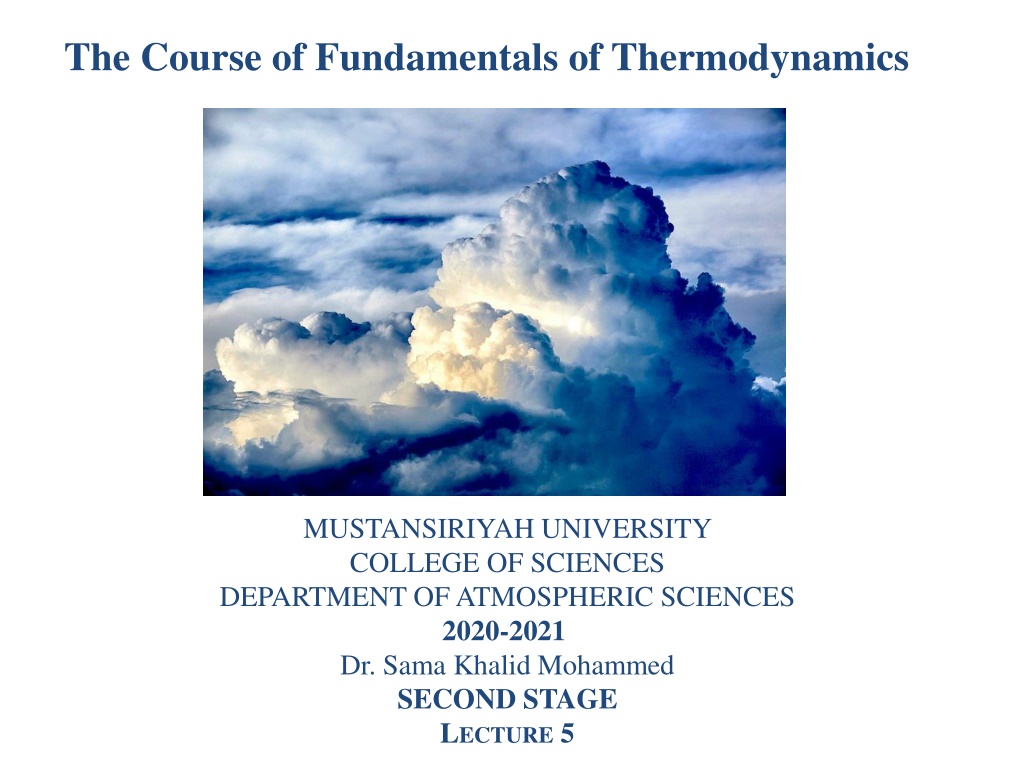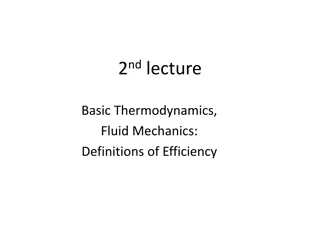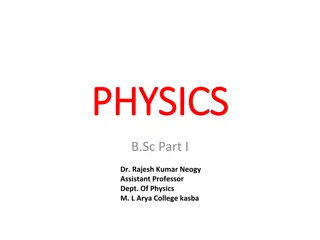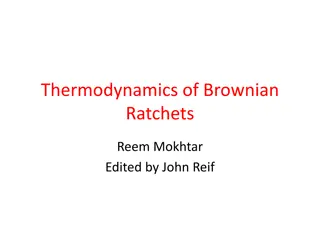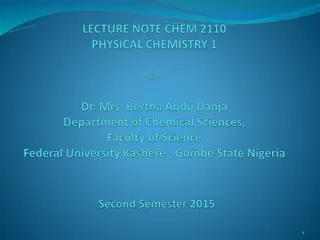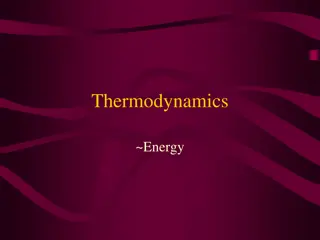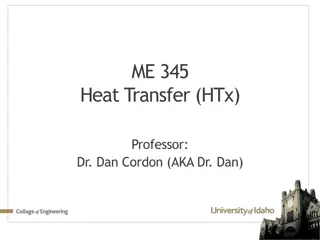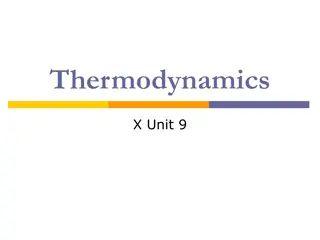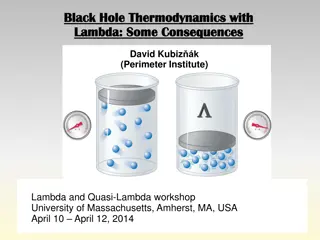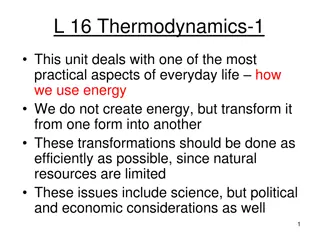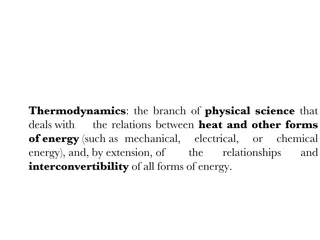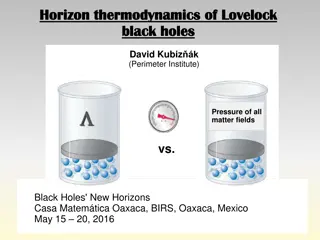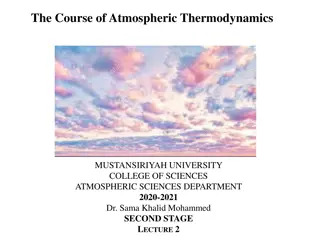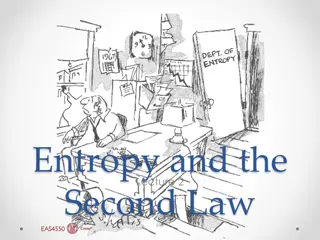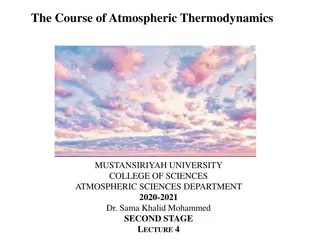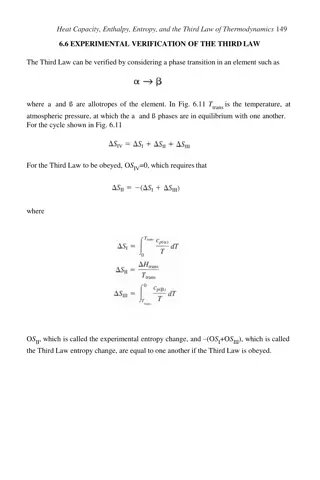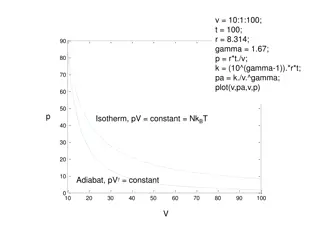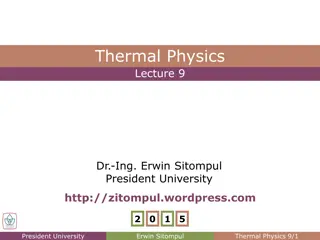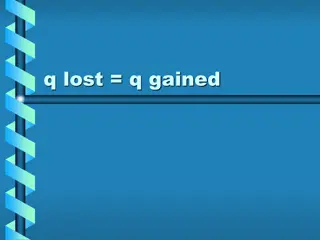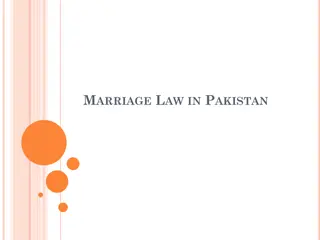Fundamentals of Thermodynamics: Historical Laws and Principles
This lecture explores the historical overview of thermodynamic laws, including Boyle's Law, Charles' Law, and Gay-Lussac's Law. It delves into the relationships between pressure, temperature, volume, and amount in ideal gases, providing useful insights for meteorologists and atmospheric scientists. The lecture also covers concepts such as the form of the ideal gas law and internal energy of ideal gases.
Download Presentation

Please find below an Image/Link to download the presentation.
The content on the website is provided AS IS for your information and personal use only. It may not be sold, licensed, or shared on other websites without obtaining consent from the author. Download presentation by click this link. If you encounter any issues during the download, it is possible that the publisher has removed the file from their server.
E N D
Presentation Transcript
The Course of Fundamentals of Thermodynamics MUSTANSIRIYAH UNIVERSITY COLLEGE OF SCIENCES DEPARTMENT OF ATMOSPHERIC SCIENCES 2020-2021 Dr. Sama Khalid Mohammed SECOND STAGE LECTURE 5
Welcome Students In The Welcome Students In The New Course New Course And In The And In The Fifth Lecture Fifth Lecture
This lecture including the following items Historical Overview of Thermodynamic Laws The ideal gases. Form of Ideal Gas Law Most Used by Meteorologists. Useful Relations for Comparing Two States of an Ideal Gas. Internal Energy of an Ideal Gas. Exercises.
Historical Overview of Thermodynamic Laws Early scientists explored the relationships among the pressure of a gas (P) and its temperature (T), volume (V), and amount (n) by holding two of the four variables constant (amount and temperature, for example), varying a third (such as pressure), and measuring the effect of the change on the fourth (in this case, volume).
Boyle's Law: The Pressure-Volume Law The volume of a given amount of gas held at constant temperature varies inversely with the applied pressure when the temperature and mass are constant Another way to describing it is saying that their products are constant. PV = C From the equation above, this can be derived: P1V1= P2V2= P3V3 etc. This equation states that the product of the initial volume and pressure is equal to the product of the volume and pressure after a change in one of them under constant temperature.
Charles' Law: The Temperature-Volume Law The volume of a given amount of gas held at constant pressure is directly proportional to the Kelvin temperature . V T Same as before, a constant can be put in: V / T = C The initial and final volumes and temperatures under constant pressure can be calculated. V1/ T1= V2/ T2= V3/ T3 etc.
Gay-Lussac's Law: The Pressure Temperature Law The pressure of a given amount of gas held at constant volume is directly proportional to the Kelvin temperature . P T Same as before, a constant can be put in: P / T = C The initial and final pressures and temperatures under constant volume can be calculated. P1/ T1= P2/ T2= P3/ T3etc.
Avogadro's Law: The Volume Amount Law It gives the relationship between volume and amount (moles) when pressure and temperature are held constant. Also, since volume is one of the variables, that means the container holding the gas is flexible in some way and can expand or contract. V n As before, a constant can be put in: V / n = C This means that the volume-amount fraction will always be the same value if the pressure and temperature remain constant. V1/ n1= V2/ n2= V3/ n3etc.
The Combined Gas Law Now we can combine everything we have into one proportion: The volume of a given amount of gas is proportional to the ratio of its Kelvin temperature and its pressure . Same as before, a constant can be put in: PV / T = C As the pressure goes up, the temperature also goes up, and vice-versa. Also same as before, initial and final volumes and temperatures under constant pressure can be calculated. P1V1/ T1= P2V2/ T2= P3V3/ T3etc.
The Ideal Gas Law The previous laws all assume that the gas being measured is an ideal gas, a gas that obeys them all exactly. But over a wide range of temperature, pressure, and volume, real gases deviate slightly from ideal. Since, according to Avogadro, the same volumes of gas contain the same number of moles, chemists could now determine the formulas of gaseous elements and their formula masses. The idea gas law is: PV = nRT
IDEAL GASES An ideal gas is a gas with the following properties: o There are no intermolecular forces, except during collisions. o All collisions are elastic. o The individual gas molecules have no volume (they behave like point masses). The equation of state for ideal gasses is known as the ideal gas law. The ideal gas law was discovered empirically, but can also be derived theoretically. The form we are most familiar with, pV = n RT Ideal Gas Law (1) R has a value of 8.3145 J-mol-1-K-1, and n is the number of moles (not molecules).
IDEAL GASES A true ideal gas would be monatomic, meaning each molecule is comprised of a single atom. Real gasses in the atmosphere, such as O2 and N2, are diatomic, and some gasses such as CO2 and O3 are triatomic. Real atmospheric gasses have rotational and vibrational kinetic energy, in addition to translational kinetic energy (Energy due to linear motion of a rigid body). Even though the gasses that make up the atmosphere aren t monatomic, they still closely obey the ideal gas law at the pressures and temperatures encountered in the atmosphere, so we can still use the ideal gas law.
Form of Ideal Gas Law Most Used by Meteorologists In meteorology we use a modified form of the ideal gas law. We first divide equation (1) pV = n RT by volume to get: ? =? ??? we then multiply the RHS top and bottom by the molecular weight of the gas, M, to get: ? =?? ? Mn/V is just the density of the gas. By defining R/M to be the specific gas constant, R , we get the following form of the ideal gas law: n = ? ? ? ? T p= R T (2) The specific gas constant is different for each gas! It is found by dividing the universal gas constant by the molecular weight of the gas.
Form of Ideal Gas Law Most Used by Meteorologists Dry air has a molecular weight of 28.964 g/mol. The specific gas constant for dry air is then 287.1 J kg-1 K-1, and is given the symbol Rd. The ideal gas law for dry air is then p= Rd T (3) or equivalently, in terms of specific volume, p = Rd T (4) =? ? ? ? ? = =
Useful Relations for Comparing Two States of an Ideal Gas One very useful consequence of the ideal gas law that it can be rewritten [from Eq. (4) for an arbitrary gas] as ? ?= R (5) This allows us to compare variables for two different states of the same gas by writing ?1 1 ?1 ?2 =?2 2 (6) As an example, imagine if a gas expands to twice its original volume while maintaining a constant pressure. From Eq. (6) we can immediately figure out the ratio of its final and initial temperatures by writing which shows that the gas s temperature would also double.
Useful Relations for Comparing Two States of an Ideal Gas As another example, imagine if a gas s pressure increases to four times its original value while keeping a constant temperature. Manipulating Eq. (6) shows that its volume would decrease to one- fourth its original size, As a final example, imagine if a gas s pressure increases to six times its original value while the volume decreases to one-fourth its original size. Manipulating Eq. (6) shows that the temperature increase by 150%,
Kinetic theory of heat Let us consider a system at a temperature T, consisting of N point masses (molecules). According to the kinetic theory of heat, these molecules move randomly at all directions (Brownian motion), and due to this randomness, the internal energies of the point-masses are not equal to each other, but they change in time. However, if we calculate the mean internal energy, we will find that it remains constant in time. Thus, the mean internal energy of each point-mass, U, is proportional to the absolute temperature of the system T = A T , A is a universal constant (A=k/2 where k is Boltzmann s constant (k = 1.38 10 23 JK 1) Assume that N = 1, Then the point has only three degrees of freedom which here are called thermodynamic degrees of freedom and are equal to the number of independent variables needed to completely define the energy of the point, then the total internal energy is equal to its kinetic energy. Thus, ???2 2 U=
Kinetic theory of heat The mean kinetic energy of a point with three degrees of freedom is equal to Note: you will need to the following relations to reach to the next equation: R=k NA and R = R/M and M=n NA m R is the universal gas constant m is the individual mass of a gas M is the Molecular weight R is the specific gas constant n is the no. of moles
Internal Energy of an Ideal Gas Since there are no intermolecular forces in an ideal gas, there is no internal potential energy. The internal energy of a monatomic gas is therefore due solely to the translational kinetic energy of the molecules (Recall from Lec.2 : Internal energy The sum of the thermal energy and any potential energy due to the forces between the molecules of a substance). If the molecules have more than one atom, then there is also kinetic energy due to rotation and vibration. o Though technically not an ideal gas, at normal temperatures and pressures the main atmospheric gasses closely follow the ideal gas law, so we can still speak of air as an ideal gas. The translational kinetic energy has a value of
Internal Energy of an Ideal Gas The rotational kinetic energy depends on whether the molecule is monatomic or multi-atomic, and whether it is linear or bent. It is o The vibrational kinetic energy is a complicated function of temperature. For light diatomic molecules (such as N2 and O2) it can be considered a constant except at extremely high temperatures. Thus, the internal energies for most monatomic and diatomic molecules are:
Internal Energy of an Ideal Gas o Note that when temperature is 0K, there is still some kinetic energy. Motion does not cease at absolute zero. An important point to notice is that, for an ideal gas, the internal energy is a function of temperature only.
EXERCISES Lecture 5 1. From the ideal gas law pV = nRT, calculate how many molecules are contained in a cubic centimeter (cm3) of air at a pressure of 1013.25 hPa and a temperature of 15 C? (R = 8.3145 J-mol 1-K 1; NA = 6.022 1023 molecules/mole) Answer: 2.55 1019 molecules 2. How many oxygen molecules are there in a cm3 of air at a pressure of 1013.25 hPa and a temperature of 15 C? Answer: 5.35 1018 molecules
